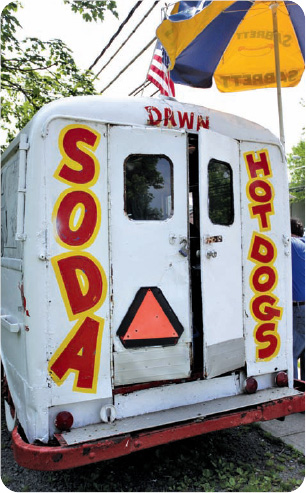
Our mothers did not look kindly on street food. A second-generation New Yorker and a thirteenth-generation New Englander, they couldn’t have had more different life experiences, but their reaction to New York City cart food? The same.
“Where do they wash their hands?”
“They touch the money and your food.”
“No, you can’t have a pretzel. I said no pretzel. That’s it, we’re leaving!”
Fast-forward a couple of decades to two young (and broke) junior editors who bonded over a love of adventurous eating on the cheap. Tired of overpriced deli salads and sad excuses for sandwiches, we began venturing out for the sort of lunches that would give our mothers heart failure. Kati rolls from the Biryani Cart, falafel from Moshe’s, lamb over rice from Kwik Meal.
Delighted by the new cuisines we discovered and emboldened by our failure to catch the plague—or any of the other maladies we’d been cautioned against—soon we were breaking the first commandment of street food eating: Thou shalt not eat fish from a cart. Perfectly crispy, golden fried fish proved to be a gateway into raw fish. Before long we were looking forward to ceviche Saturdays at the Red Hook Ball Fields (shhhh, don’t tell Mom).
In time, we became regulars at several carts around midtown, and through the friendships we formed with the owners, we began to hear the stories behind the food—tales of the good (and the bad) old days in the city. Every plate of chicken over rice came with a story.
In recent years trendy food trucks selling everything from Korean tacos to crème brûlée have captured the popular imagination, but street vending is far from new in New York City. Numerous waves of immigrants have found the promise of a better life in street vending, bringing a bit of the old country to the New World.

Prior to the Civil War, Irish women known as “Apple Marys” hawked apples in the Financial District, while Hot Corn Girls sold roasted corn on streets of the infamous Five Points alongside sweet cake vendors and fruit peddlers. As the German, Italian, and Jewish populations swelled, they brought sausages, vegetables, ice cream, bread, and smoked fish, among other delicacies. Lower East Side stalwarts Russ & Daughters, Guss’ Pickles, and Yonah Schimmel Knish Bakery all had their beginnings in pushcart vending. In more recent years, Latin vendors of all stripes have introduced pan-American fare from icy cold horchata, sweet fried plantains with queso and crema, and mammoth chorizo huaraches, while Egyptian and Afghanis have found opportunity in selling fiery hot sauce–doused halal chicken and lamb pitas and platters to hungry cabbies and office dwellers alike.

A city of old and new immigrants, New York offers unparalleled dining diversity. Where else in the world can you find Korean, Jamaican, Austrian, Taiwanese, Greek, Israeli, Belgian, Indian, Bangladeshi, Trinidadian-Pakistani, Moroccan, and Mexican street food within a ten block radius? The city streets abound with deliciousness that is begging to be explored. There’s street food for every budget and for eaters bold and timid alike (the aforementioned moms are even beginning to come around on a case-by-case basis).
As we swapped stories with vendors, one thing became clear: behind every cart and every truck were the hopes and dreams of a fellow New Yorker by birth or by choice. With this collection of stories and recipes, we hope to honor the tireless vendors who came before and those who rise each day before the sun to feed the soul of the city one meal at a time.